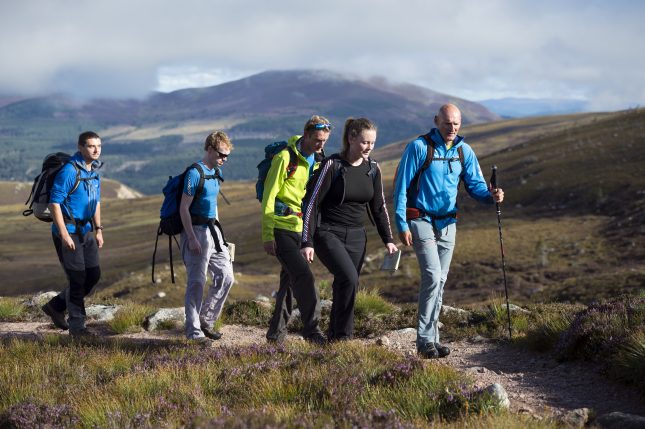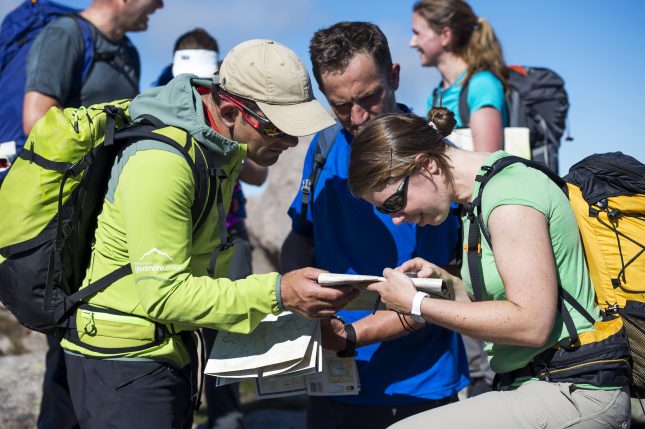Summer Mountain Leader Training FAQs
The Mountain Leader award was established to promote the safe enjoyment of the hills and mountains of the UK and Ireland. Summer Mountain Leader Training is a key step for many who are looking to turn their passion for the outdoors into a career.
Senior Instructor at Glenmore Lodge, Bill Strachan has been delivering Summer Mountain Leader Training courses and assessments for several years. Here he answers some frequently asked questions and shares advice for those who may be considering undertaking the training, or are anticipating their course in the coming season.
Who is the Summer Mountain Leader Training for?
Everyone! All sorts of people attend Summer Mountain Leader (ML) training courses. Munro baggers, parents, people who have tended to follow partners or friends around and want to become independent in the hills, those who want to have a career in the outdoors, and those who started walking for exercise, their wellbeing, or just to enjoy the outdoors and are looking to learn more.
The organisation responsible for the Mountain Leader scheme is Mountain Training. This is who you register with at the start of your ML journey. They also set the syllabus that course providers follow when delivering your training. This means that though the style of different providers may differ, the content covered by the course, the standards expected of candidates in assessment, and of the staff delivering training courses and assessments too, are all consistent. To help candidates meet these standards, Mountain Training and course providers strive to support anyone who feels disability may prevent them from attending. Get in touch with your training provider about any additional needs you may have. They’ll be able to make reasonable adjustments to enable you to get the most out of your course.
Before attending training, candidates need to log 20 ‘Quality Mountain Days’ (QMDs) in their digital logbook. We’ll come back to what this means in more detail later, but what it essentially amounts to is a reasonable bit of hillwalking experience. You aren’t expected to be an expert, but nor should you be completely new to the mountains. Because the ML is a leadership award, you should be comfortable enough in the hill environment that you’re properly able to take in the content of the training.
.

.
What does the Summer Mountain Leader Training involve?
At the start of the week, the course director/your Instructor wants to get to know you and the other candidates by chatting to you all. They’ll have already looked through your logbooks to get an idea of your experience. Throughout the training, your Instructors will be demonstrating some of the things that as a regular hillwalker you don’t necessarily think about. It’s an opportunity to explore the differences between you going up a hill as you usually would, and leading others. When doing the latter, there are more things to be thinking about such as the pace you’re going at, and the experience and ability levels of your group.
While each day of the course will typically focus on particular aspects of the syllabus, the common themes of leadership, environmental awareness, and navigation are present throughout the week. Both training courses and assessments try to be as holistic as possible. The course is full of opportunities to learn from one another in a collaborative way, including debriefs at the end of the days.
Frequently Asked Questions:
What is a Quality Mountain Day?
The candidate handbook details the criteria for a QMD, but another way of looking at it might be that if you get home from a day and can’t wait to tell someone else (or maybe you feel a bit smug about what you did), then that is likely a QMD! Things that don’t qualify are instances where you’re out and there are safety nets in place, such as organised events, days spent with a qualified ML, or training courses. Typically DofE (Duke of Edinburgh) days aren’t QMDs… it’s the journey that should be demanding, not the company! Or routes that repeat ground you’ve been on before or take well-travelled paths such as the tourist track up Ben Nevis.
It’s also good to have learned something from these days out in the hills as well. It’s fairly common to see people who have 20 days in their logbook that wouldn’t necessarily qualify because they haven’t had the feedback on their days out to fully understand what a QMD is. But part of the learning process is having the experience our in the hills to get your head around what the paper definition of a QMD means in reality.
Any advice for those who struggle to retain environmental knowledge?
Plenty of people find this challenging, but you don’t need to know the Latin names for every species in the hills or be a fountain of all knowledge. The ML Training is a good opportunity for people to learn from one another about flora and fauna, and you just need to find a way that works for you. Rather than scientific information, you may find facts about what plants have been used for by people in the past to be more interesting. The aim of the ML scheme isn’t that everyone is out repeating the exact same information. It aims to create decision makers who inspire and can find common topics of conversation that engage those you’re walking with.
What level of navigation ability do I need?
It isn’t a week-long navigation course, so it’s generally good to be familiar with using a map and compass. And most candidates leave after completing their week with more still to learn about navigation and a better awareness of how they can improve. The course should highlight areas for improvement, give you additional strategies, and encourage you to become more confident.
.

Do I need to have been on a scrambling course?
You don’t need to have a significant level of scrambling experience. However, it’s useful if you can be comfortable on steeper terrain as it may help with allowing you the headspace to manager your group better. If you’ve never been scrambling before, it’s worth spending a bit of time on some grade one scrambling terrain so you can be comfortable in the environment. But there’s no need to go out and become a climber. The ML isn’t about being on graded ground, but you should be able to operate comfortably on the type of steep grass or scree in which a group member might need a helping hand.
Does the Summer Mountain Leader Training look at specific scenarios or skills required for being in a leadership role?
In the context of the ML award, being a leader is about creating appropriate environments by recognising and working with the best ways the people in your group can perform well, enjoy themselves, improve their skills, and achieve their goals. People tend to learn the soft skills of leadership from their life experience. While the ML Training doesn’t go into specific activities or elements of leadership such as conflict resolution, leadership is a key theme throughout the week and an assessed part of the syllabus.
Assessment
After you’ve attended a training course, there is a consolidation period. You should continue to gain experience and improve your skills before undertaking the Mountain Leader Assessment. The detail and pre-requisites for the assessment can be found it the Candidate Handbook on Mountain Training’s website. Between training and assessment, you should have completed 40 QMDs in three mountain regions of the UK and Ireland, and 8 nights of camping. At least four of these nights should be wild camping. This requires you to work hard to leave the environment as you found it, and more planning and thought.
It’s natural to compare yourself with others and doubt your abilities. But it’s important to remember that you’re being measured against the syllabus rather than others on the course. Nor do you need to be absolutely perfect to pass. Assessors pass people who have the ability to be safe in the mountains and become brilliant leaders. If you fail or receive a deferral, the assessor works with you to provide feedback on your performance against the standard. They’ll help provide an action plan so you can go on and improve in the necessary areas.